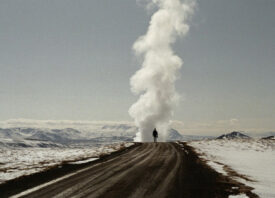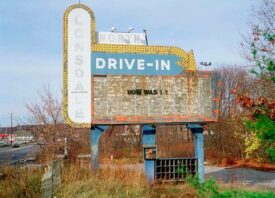Search this site
A Lyrical Photographic Road Trip Across America



“The Road Not Taken,” a 1916 poem by Robert Frost is not merely a call for following one’s own destiny as many would like to believe, but the knowledge that for every gain, there is an equal and opposite loss — though these truths may not be readily visible to us. When faced with a fork in the road we have three options, including retreat; no matter which we choose can never know what fate would have befallen us had we gone another route.
The desire to take the road “less traveled by,” Frost assures us, “made all the difference” to his journey, a decidedly neutral decree that many have willfully interpreted as an tacit endorsement. The Beat poets, who desperately sought to get off the beaten path, imagined a mythic America beyond the cityscape. They hit the open road with a profound need to escape, in a search for meaning that has inspired generations to do the same.
Yet the belief that one could “find” themselves while traversing stolen land reveals the depth to which the colonizer’s mindset has penetrated and shaped the ethos of the avant garde. This mythic America, now reduced to an ignoble epigram that appears in white block letters on red baseball caps, is one of the most enduring and romantic constructions of Western cultural hegemony.



Arnaud Montagard, a French photographer living in Brooklyn, traversed the continent, making a series of exquisite photographs just published in the sumptuous new book The Road Not Taken (Setanta Books). Here, the search for signs of this fantastical realm continues with the fervor of a true believer, cataloguing the iconography of the self-made man whose rugged individualism built a nation from scratch.
Here in a world that Manifest Destiny made we revel in glorious scenes of yesteryear, a place where time stopped just as Civil Rights began. Art Deco hotels, mid-century modern diners, muscle cars, elk heads mounted on wood panel interiors, neon script signage, candy stripe awnings, and a tri-colored barber shop riot gate are brought together in charming albeit familiar scenes of American vernacular.
But what lurks beneath the scenes we know so well, the Coca Cola bottles, ice cream floats, and vintage cars? What of the book’s only true portrait, a photograph of a grizzled Black man with a sideways cap and a cigarette perched in his mouth — is he a folksy emblem of “simpler times” or is his image, the smallest in the book, the clue to a much deeper, more meaningful truth?
The United States has long attracted immigrants who could imagine for themselves the possibility of living the American Dream without having to consider what it cost people who didn’t chose to come here of their own free will, or those whose land was stripped from them to make highways the highways and back roads that fascinated the Beats. “Until the lion learns how to write, every story will glorify the hunter,” Zimbabwean author J. Nozipo Maraire famously wrote, reminding us of the enduring presence of imperialist subtext in traditional American iconography.



All images: Arnaud Montagard



